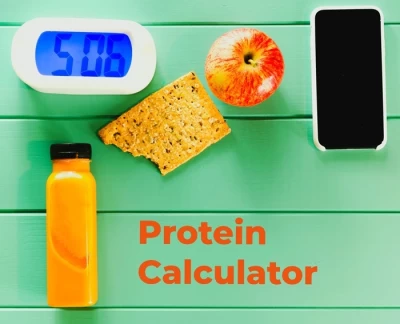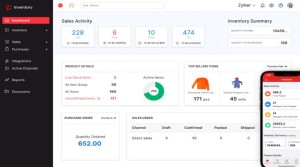10 Tips to Master Your Protein Calculator for Peak Performance
Discover how to fine-tune your protein intake for muscle growth and recovery, and transform your protein calculator into a powerful ally in achieving your athletic goals.

Hey there, fitness enthusiasts! Protein is certainly universal in the concept of how it helps build and maintain muscle mass. However, protein intake has so many different variables that it could start to feel like you are at the heart of an unimaginably difficult scientific equation. Fortunately, protein calculators automatically make the calculations, taking this "headache" off.
However, just throwing your weight and age into the calculator is likely not going to be your golden ticket to truly maximize your fitness results. Now let's reveal the secret behind the powerful protein calculator. It's the 10 steps guide that turns your protein calculator from a mere tool into a smart and effective instrument that helps you to become an ultimate athlete.
1. Beyond the Basics
Standard protein calculators typically ask for your weight, height, and age. While these provide a basic framework, advanced calculators offer a deeper dive by considering additional factors that significantly impact your protein needs.
- Body Composition
Muscle mass burns more calories than fat tissue. Individuals with a higher percentage of muscle mass will naturally require more portein to support those metabolically active tissues.
- Activity Level
From weekend warriors to elite athletes, activity level dramatically impacts protein requirements. The intensity and duration of your taining sessions directly correlate to the amount of protein your body needs for recovery and muscle protein synthesis (MPS).
- Training Split
Are you a strength training enthusiast focused on building raw power? Or perhaps your focus lies in achieving hypertrophy, or increased muscle size? The specific training program you follow influences your protein needs. Strength training routines typically require a slightly lower protein intake compared to hypertrophy-focused programs.
By incorporating these advanced options, your protein calculator delivers a more personalized estimate that accurately reflects your unique body and training demands.
2. Digging into the Data
Some of the advanced protein calculators show the protein consumption ranges. Do not just simply cast these numbers off as being accurate. Spend time on discovering the scientific considerations behind the curriculum coverage. Here's a breakdown of these considerations.
- Lower End of the Range
The diet is generally calculated to provide the recommended minimum amount of protein you need to keep your current muscle mass. This is suitable for those who emphasize general fitness or those who experience calorie deficiency for fat loss.
- Higher End of the Range
This amount represents the protein consumption, which is enough for the greatest amount of muscle mass growth and recovery. This is the perfect solution, especially for a sports person or for those who have intense exercises designed to increase muscle mass.
By knowing the rationale behind it, you can be well-informed on the quantity of protein you require so that it matches your fitness regimen objective.
3. Quality Over Quantity
Not all protein sources are created equal. While protein calculators focus on quantity (grams of protein), you should prioritize quality (protein source) for optimal results.
Focus on high-quality, bio-available protein sources like whey protein, chicken breast, salmon, and eggs. These sources are readily absorbed and utilized by your body for muscle protein synthesis. Processed meats and certain plant-based protein sources might require higher intake levels due to lower bio-availability.
4. Beyond the Estimate
Protein calculators provide valuable estimates, but they can't account for every dietary nuance. To ensure you're hitting your protein targets consistently, religiously track your daily protein intake using a food diary or a mobile app. This allows you to identify and discrepancies between your estimated and actual intake and make adjustments accordingly.

5. Personalization is Key
While calculators give a starting point for the protein eaters the response of the person to the protein level varies. It is indispensable to follow your own body's signals and feeds as no one else knows your body better than you. More fatigue, muscle twinges, or long-term hunger can be impulses to increase the amount of protein that you take.
On the contrary, overdoing your daily protein intake is no better than just meeting your needs, probably, you will only feel uneasy. Monitor your body's response to different protein levels and adjust the calculator's estimates accordingly.
6. MPS Sweet Spot
Optimal protein intake for muscle protein synthesis (MPS) suggests around 0.4g per kg of body weight per meal. To maximize MPS, evenly distribute a moderate protein amount across meals, spacing them 3-4 hours apart. This strategy ensures a consistent amino acid supply, supporting muscle recovery and growth.
7. Spread it Out
Protein is important in building and repairing muscle tissues, so make sure to distribute it evenly throughout the day. This will help your muscles process it efficiently, rather than in large amounts that may be overwhelming to your body at once. Try to be regular with your protein intake and distribute it evenly over the whole day.
8. Re-Evaluate Regularly
You might find that your protein consumption requirements vary depending on your age and developmental stage. Factors, for example, muscle mass growth, injury, or even stress, play roles that demand an increase in protein requirements. Reconsider the calculator 2-3 months after if it is possible.
9. Protein Myth Busters
Many misconceptions surround protein. Such an instrument can dispel those myths like flying on a cloud of "protein is damaging kidneys" (the statement is generally untrue).
10. Don't Be a Slave to the Numbers
The calculator has an advantage over us, but not completely. Consider it a guideline, and modify the points as you are impacted and like/dislike it more.
Tip: Jump in knowing D1R as a protein calculator and carry forward your meal plan. This way, you are not only going to get some protein but also a balanced intake of all the essential nutrients for good health and performance. Thus, leading to a healthy body.
Also Read: Benefits of Using a One-Rep-Max Calculator

Hey there, fitness enthusiasts! Protein is certainly universal in the concept of how it helps build and maintain muscle mass. However, protein intake has so many different variables that it could start to feel like you are at the heart of an unimaginably difficult scientific equation. Fortunately, protein calculators automatically make the calculations, taking this "headache" off.
However, just throwing your weight and age into the calculator is likely not going to be your golden ticket to truly maximize your fitness results. Now let's reveal the secret behind the powerful protein calculator. It's the 10 steps guide that turns your protein calculator from a mere tool into a smart and effective instrument that helps you to become an ultimate athlete.
1. Beyond the Basics
Standard protein calculators typically ask for your weight, height, and age. While these provide a basic framework, advanced calculators offer a deeper dive by considering additional factors that significantly impact your protein needs.
- Body Composition
Muscle mass burns more calories than fat tissue. Individuals with a higher percentage of muscle mass will naturally require more portein to support those metabolically active tissues.
- Activity Level
From weekend warriors to elite athletes, activity level dramatically impacts protein requirements. The intensity and duration of your taining sessions directly correlate to the amount of protein your body needs for recovery and muscle protein synthesis (MPS).
- Training Split
Are you a strength training enthusiast focused on building raw power? Or perhaps your focus lies in achieving hypertrophy, or increased muscle size? The specific training program you follow influences your protein needs. Strength training routines typically require a slightly lower protein intake compared to hypertrophy-focused programs.
By incorporating these advanced options, your protein calculator delivers a more personalized estimate that accurately reflects your unique body and training demands.
2. Digging into the Data
Some of the advanced protein calculators show the protein consumption ranges. Do not just simply cast these numbers off as being accurate. Spend time on discovering the scientific considerations behind the curriculum coverage. Here's a breakdown of these considerations.
- Lower End of the Range
The diet is generally calculated to provide the recommended minimum amount of protein you need to keep your current muscle mass. This is suitable for those who emphasize general fitness or those who experience calorie deficiency for fat loss.
- Higher End of the Range
This amount represents the protein consumption, which is enough for the greatest amount of muscle mass growth and recovery. This is the perfect solution, especially for a sports person or for those who have intense exercises designed to increase muscle mass.
By knowing the rationale behind it, you can be well-informed on the quantity of protein you require so that it matches your fitness regimen objective.
3. Quality Over Quantity
Not all protein sources are created equal. While protein calculators focus on quantity (grams of protein), you should prioritize quality (protein source) for optimal results.
Focus on high-quality, bio-available protein sources like whey protein, chicken breast, salmon, and eggs. These sources are readily absorbed and utilized by your body for muscle protein synthesis. Processed meats and certain plant-based protein sources might require higher intake levels due to lower bio-availability.
4. Beyond the Estimate
Protein calculators provide valuable estimates, but they can't account for every dietary nuance. To ensure you're hitting your protein targets consistently, religiously track your daily protein intake using a food diary or a mobile app. This allows you to identify and discrepancies between your estimated and actual intake and make adjustments accordingly.

5. Personalization is Key
While calculators give a starting point for the protein eaters the response of the person to the protein level varies. It is indispensable to follow your own body's signals and feeds as no one else knows your body better than you. More fatigue, muscle twinges, or long-term hunger can be impulses to increase the amount of protein that you take.
On the contrary, overdoing your daily protein intake is no better than just meeting your needs, probably, you will only feel uneasy. Monitor your body's response to different protein levels and adjust the calculator's estimates accordingly.
6. MPS Sweet Spot
Optimal protein intake for muscle protein synthesis (MPS) suggests around 0.4g per kg of body weight per meal. To maximize MPS, evenly distribute a moderate protein amount across meals, spacing them 3-4 hours apart. This strategy ensures a consistent amino acid supply, supporting muscle recovery and growth.
7. Spread it Out
Protein is important in building and repairing muscle tissues, so make sure to distribute it evenly throughout the day. This will help your muscles process it efficiently, rather than in large amounts that may be overwhelming to your body at once. Try to be regular with your protein intake and distribute it evenly over the whole day.
8. Re-Evaluate Regularly
You might find that your protein consumption requirements vary depending on your age and developmental stage. Factors, for example, muscle mass growth, injury, or even stress, play roles that demand an increase in protein requirements. Reconsider the calculator 2-3 months after if it is possible.
9. Protein Myth Busters
Many misconceptions surround protein. Such an instrument can dispel those myths like flying on a cloud of "protein is damaging kidneys" (the statement is generally untrue).
10. Don't Be a Slave to the Numbers
The calculator has an advantage over us, but not completely. Consider it a guideline, and modify the points as you are impacted and like/dislike it more.
Tip: Jump in knowing D1R as a protein calculator and carry forward your meal plan. This way, you are not only going to get some protein but also a balanced intake of all the essential nutrients for good health and performance. Thus, leading to a healthy body.
Also Read: Benefits of Using a One-Rep-Max Calculator
Conversation
Latest Blogs
© Blog CoolCalculator, Explore CoolCalculator, your destination for the latest insights, tips, and updates on the world of online calculators. Stay informed and make your calculations smarter with our blog. ,
Designed
by Saad Media Team , Team Lead M.Rizwan Akhtar












